As we in Australia take the first hesitant steps beyond "rugged individualism" and begin to re-learn the skills needed to govern ourselves in community, the private-within-commons system tends to sit more comfortably with many.
By David Holmgren
Published October 21, 2005
This essay first appeared on David Holmgren's website. It is reproduced here with permission.
The suburbs of our Australian cities have, in the main, become sterile wastelands, lacking in any true spirit of community, impoverished of local resources, and filled with fearful people whose daily efforts are focused elsewhere. What has happened to the Australian "suburban dream"?
To find the foundation of the so-called 'suburban dream' and the reasons why it has proved illusory, we need to look back to the post World War II economic boom of the 1950s. At that time, Australia was riding high on the sheep's back, with wool prices around $2.40 [Australian dollars] per kg, and there was also cheap and abundant fossil fuel and timber.
Furthermore, the government of the period provided widespread war-service housing, low-interest loans, and substantial public infrastructure such as roads and utilities to facilitate suburban growth.
The typical 'baby-boom' family of the 1950s lived on a single income of around $50-$100 per week, with a housewife and three children at home. These home owners, who had grown up through the "Great Depression" and wartime hardships, had an ethos of proud self-reliance and domestic frugality, reinforced by their wartime experiences.
Many suburban 'back yards' had an actively worked vegetable garden and one to a few productive fruit trees. Produce swapping and home preserving of seasonal surpluses were common. And this was also the heyday of several great consumer icons - the FJ Holden car, the Victa lawnmower, and the Hills Hoist clothesline.
But there were problems with the suburban dream and the resulting rush of young families to "nappy valleys" on the city fringes, notably "urban sprawl". As the suburbs spread, they displaced important agricultural activities such as the market gardening and dairy farming that formerly provided fresh foods with minimal need for transport.
Not only did public infrastructure become increasingly poorly used, but the disproportionate rush to build roads and sell more Australian cars led to a general decline in the use of public transport - leading eventually to the phenomenon we see today, that our suburbs are designed for cars not people.
Along with "sprawl" has developed an increasingly dysfunctional economic situation. We see speculative inflation of land values, capital invested unproductively, declining household (non-monetary) production of food and "backyard industry", and a massive rise of consumer addiction based on rising household debt.
Large areas of our cities have become "dormitory suburbs". The average household size is declining while ever-larger homes are increasingly empty during the working day. Their blind windows look out onto streets empty of people (but all too often filled with cars). There is an alienating lack of community resulting, ultimately, in increased crime and fear.
The conventional responses to this situation are familiar to us all. The first is a change of planning regulations to encourage increasing density, promoting smaller housing blocks in new developments, dual occupancy infill development, and medium-density redevelopment of older areas.
Residents themselves have responded independently in various ways through their lifestyles. The renovation obsession is frequently directed at producing more high-value house space at the expense of the 'back yard'. Then there is a mobile lifestyle and semi-abandonment of home, when eating out and leisure activities elsewhere compound the daily absence during work hours.
There is also the move to get rid of garden maintenance and commuting by moving to inner-city apartment living; and, at the other end of the scale is the "super-suburb" response of moving to a rural-residential or hobby-farm property beyond the new suburban fringe.
In recent years, as we have become more aware of the negative effects of our high-impact lifestyles, a number of environmental responses have also been introduced - such as building insulation, energy-efficiency requirements, improvements to public transport, conservation of urban green space, and more water-sensitive urban design.
We have barely scratched the surface, however, of the profound improvements that the application of permaculture principles and strategies could deliver for the sustainability and livability of today's suburbs - for example:
Food security based on gardening: Food security through retention of horticultural production within and close to cities, has barely been on the agenda, while home gardening is largely ignored as irrelevant to the sustainability debate.
For many of today's urban residents, where food comes from beyond the supermarket is barely on their radar. We are still fixated on the high-density European-style city that gets its food from somewhere else. Most are unaware of different patterns of urban living such as those of Japan, China and other Asian countries where cities have traditionally contained interspersed gardens and rice paddies.
If food is produced in distant places, its supply is more vulnerable to risks (such as increased transport costs) that we cannot control. For urban residents aware of the fragility of the food supply system, home gardening is a practical activity that can provide much of the fresh food of a family, and also bias the diet away from over-consumption of animal protein and towards vegetables and fruit.
Even when the level of production is small, the seasonal garden maintains the skills necessary to produce food and passes those skills on to the next generation.
Better health through a culture of home food consumption: Consumption of genuinely fresh fruits and vegetables from a local garden can underpin good health and combat the current obesity epidemic. In the same way that wood warms you twice - once when you split it and once when you burn it - garden produce keeps you healthy when you grow it and also when you consume it.
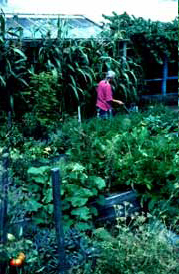
Local Gardening
Economy through home food production and food preservation: Growing food at home and preserving seasonal surpluses bypasses the so-called "value-adding" processes of the commercial food chains, and means food is much less expensive - a principle readily understood by families of the Great Depression and WWII years.
Firewood for sustainable and ethical energy: The permaculture strategy of burning waste wood from landscaping and building for space heating, water heating and cooking allows urban residents to be more energy self reliant, while keeping a valuable resource from going to landfill (to generate greenhouse-intensive methane) or into inefficient, noisy, fossil-fuel-driven chippers and mulchers.
How many of us realise that our cities are actually big forests? The expanding areas of new plantations and natural regeneration within or near cities all need continuous thinning to reduce fire hazard and improve timber and ecological values.
With careful management and better education, there is much valuable wood that could be saved for fuel. Wood has a high energy density, is greenhouse-gas neutral, and can readily be made available as smokeless charcoal for city use. With maximum pollution occurring through smoke emission right at the point of use (cf. distant coal-fired power stations), there is a useful negative feedback that controls user behaviour.
Passive solar design combined with thermally efficient natural materials: Building with rammed earth, mud brick, recycled timber and salvaged joinery, for example, greatly reduces the embodied energy of a dwelling while providing 'character' to designs and thermal mass to control temperature fluctualtions. This is in contrast to the conventional regulatory emphasis on energy efficiency through insulation alone. Unfortunately, this emphasis often leads to suppression of real innovation even while it "raises the floor" for lowest performance.
Retrofitting attached greenhouses to existing homes: An attached greenhouse can help capture warmth from the sun while extending the garden growing season.
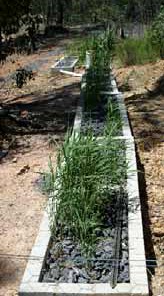
Gravel Reed Bed
Water harvesting and natural wastewater treatment: In many coastal areas of Australia (where the greatest proportion of us live), the rain that falls on the roof should, if used innovatively, be sufficient for at least the majority of home uses, including gardening. Rainwater harvesting can be supplemented by treatment of greywater (from the bathroom, laundry, and kitchen) e.g., through, gravel reed beds, for subsequent use in the garden.
Even blackwater (from the toilet) can be treated and re-used on site in some circumstances, or a waterless composting toilet can be installed to ensure water goes to more productive uses. Closing the nutrient cycle, from human waste to fertile, food-producing soil is, in the longer term, one of the most critical factors in the sustainability of urban populations.
Animals in productive garden ecosystems: Hens and ducks are excellent components of a sustainable suburban garden system and can significantly expand the range and value of foods produced at home. They deal with various types of food waste and pests such as insects and slugs, while their manure adds natural fertiliser to the soil.

Reclaim the Streets
Reclaiming the streets: Making greater use of our public space - most notably our streets for walking and cycling - reduces the costs of transport, enhances knowledge of the local area, and contributes to better community.
The more we expand these uses, the more the destructive uses of public space (such as excessive car traffic and vandalism) are gradually displaced. It is high time residents reclaimed their suburban streets for people. They should again be available for children to play and safely learn their cycling skills.

Recumbent Bicycle
Creative recycling: Making creative use of discarded goods and wastes is a classic permaculture strategy that is far more innovative and productive than most industrial recycling systems, such as smashing and melting down bottles.
My own 16-year-old son, for example, built himself a fully functional recumbent bicycle from "rubbish". We have a shortage of innovative skills, not materials. Creative re-use and re-manufacture could greatly extend the lifecycle of many consumer goods.
City farms and community gardens: Cooperative gardening and farming of city open spaces allows these productive activities to move beyond backyard scale, opening up a further range of possibilities for food production and community engagement.
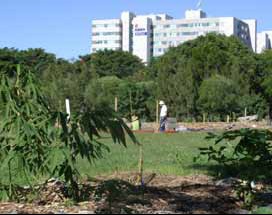
Community Garden
New ways of trading: Locally based trading systems retain the energy of participants within the local community, rather than draining it away to some different location. LETS systems are a good example, some of which may also have associated local currency or tokens for ease of exchange. Local exchange systems allow citizens to wrest back some control of their economic wellbeing from the increasingly unstable, national and global monetary systems.
New ways of sharing land: Traditionally, Australia has acknowledged only two forms of land ownership - fully private and fully public. Recently, however, there has emerged a new option - that of commonly owned land - providing new opportunities for community formation and cultural innovation.
Eco-villages and co-housing schemes are beginning to appear which combine 'ecological' building with common infrastructure and community governance. The actual housing lots and dwellings in the scheme can be part of the 'commons', or privately owned within a broader common title.
As we in Australia take the first hesitant steps beyond "rugged individualism" and begin to re-learn the skills needed to govern ourselves in community, the private-within-commons system tends to sit more comfortably with many.
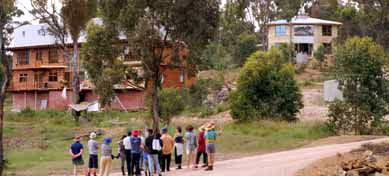
Sharing Land
The importance of the above options becomes clear when we ask the question "What if energy availability declines?" Beyond the abundant availability of fossil fuels is an uncertain energy future that has been pictured in various scenarios that range from "techno-fantasy" (e.g., unlimited nuclear cold fusion with no unforseen negative impacts) - an absurdly optimistic scenario but frightening in its implications for humanity and the planet - to an "Atlantis-like" fate in which our culture "goes under".
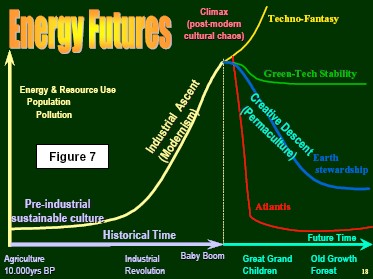
Energy Futures: Sustainability lies between techno-fantasy and Atlantis
Most of the sustainability debate is focused within the "green-tech stability" scenario in which we essentially maintain a steady (albeit somewhat reduced) level of energy usage by progressively moving to renewable sources such as wind, solar, tidal power, etc., as fossil fuel reserves are used up.
While permaculture strategies mesh nicely with many of those directed towards this generally accepted desirable future, permaculture in fact defines a creative response to a fourth scenario that I call "Earth Stewardship" - a "creative descent" in which we progressively reduce our energy demands to return eventually to living within the natural energy and production budget of the land we occupy. Elements of all these scenarios can be found in the wide-ranging viewpoints and arguments of today's "sustainability" debates.
In the Earth Stewardship "creative descent" scenario, which I consider to represent the only truly sustainable future, human society creatively descends the energy demand slope essentially as a 'mirror image' of the creative energy ascent that occurred between the onset of the industrial revolution and the present day.
The actual sustainable plateau is a long way down from current energy demands, but also a long way ahead in time. If we begin our journey now, there is time to use our familiarity with continuous change and creative innovation to avoid bringing on "Atlantis".
So, in an energy-descent future, what are the prospects close to home - here where we live in suburbia? Will it be the end of suburbia? What if we can no longer afford to commute to work by car? What if we are dependent on food and energy supplies that are transported long distances at increasing expense? What if the services and functionality of our communities decline further so that there is ever-diminishing support from local councils and police, for example?
There is a real and viable alternative to this seemingly alarming scenario - a retrofit of suburbia - a remodelling of local neighbourhoods and communities for the energy-descent future. The "refit manual" will bring together and integrate features such as:
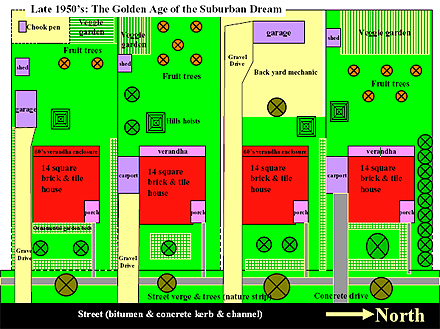
Late 1950s: the Golden Era of the Suburban Dream
Let's paint a specific picture of how this might work. If we return briefly to the golden age of the suburban dream in the late 1950s, a birds-eye view of our suburban neighbourhood might have looked something like the image above, which shows four standard suburban blocks with productive backyards, including one supporting a small service enterprise.
If we move on in time and look at the same small neighbourhood in the 1990s, the image below shows the typical effects of affluence, aging and infill. The backyards are now all unproductive as aging original householders are no longer gardening or working at home.
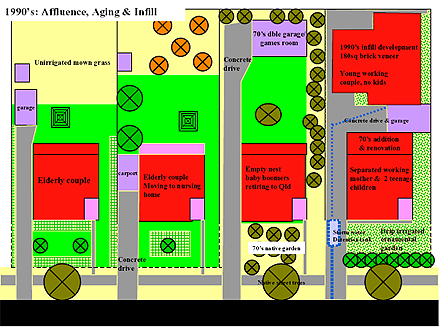
Late 1990s: Affluence, Aging, and Infill
The cottage industry workshop has been renovated as an addition to the house space, and one property has been sold for speculative investment and the backyard filled with a second dwelling. How can this decline in productivity be turned around?
Let's leap a few years ahead into the late 2000s and imagine what might now have been done with the same four properties. The catalyst has been the sale of the house second from left to an energetic young couple determined to "future-proof" themselves for the energy descent expected in their lifetime. Using permaculture principles, they have restructured their entire block, including its front garden, as an integrated food production system.
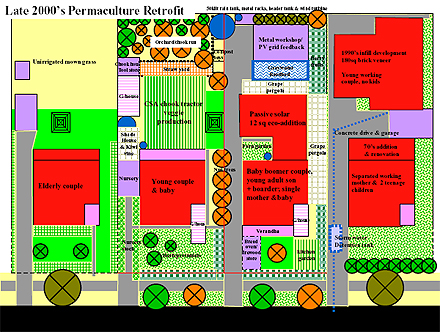
Late 2000s: Permaculture Refit
Seeing this exciting new development on the other side of the fence, the empty-nest baby boomers in the property third from left have aborted their migration to Queensland and restructured their home and lifestyles along lines compatible with the initiatives of their neighbours.
They have extended their home with an eco-addition and increased its occupancy with an additional family member plus a young boarder. The 1970s games room has been fitted with a solar PV array and returned to its original 'backyard-industry' purpose to house their son's small metal-working business.
The fence between the two properties has been removed to allow the land of both blocks to be farmed cooperatively for the benefit of all the occupants. Shared water management facilities, including rainwater collection and greywater treatment, have been implemented, and productive fruit trees have been planted on the nature strip in front of both houses.
The complementary design relationship between the two households is characterised by horticultural skill and youthful energy but not much capital on the left, and more capital and more interest in the built environment and social strategies of permaculture on the right.
Seeing all these successful communal activities going on next door, the property owners on the left- and right-hand ends of the row are now looking for ways to contribute. The elderly couple on the left need home help (an opportunity for one of the young mothers) in exchange for use of their extensive backyard to expand the cooperative CSA vegetable-box garden.
While the development and neighbours in the right may be slower and more difficult to connect, they have offered their unused back and front gardens to extend the farming system in return for a share of the produce, one of their teenagers is training to help in the metal-working enterprise, and their stormwater detention tank will shortly be refitted as part of the communal water management system. And so it grows...!
The bottom line here is that we do not need to wait for policies to change. We can choose today to do this - to create our own small neighbourhoods.
'Suburban sprawl' in fact give us an advantage. Detached houses are easy to retrofit, and the space around them allows for solar access and space for food production. A water supply is already in place, our pampered, unproductive ornamental gardens have fertile soils and ready access to nutrients, and we live in ideal areas with mild climates, access to the sea, the city and inland country.
So what do we have to do to make it work? Basically, the answer is "Just do it!" Use whatever space is available and get producing. Involve the kids - and their friends. Make contact with neighbours and start to barter. Review your material needs and reduce consumption. Share your home - by bringing a family member back or taking in a lodger, for example.
Creatively and positively work around regulatory impediments, aiming to help change them in the longer term. Pay off your debts. Work from home. And above all, retrofit your home for your own sustainable future, not for speculative monetary gain.
In an energy-descent world, self-reliance represents real opportunities for early adopters of a permaculture life style:
There are, however, some real hazards for the greater community in the energy-descent scenario. For example, perverse subsidies and "head-in-the-sand" policies could distort necessary market adjustments (e.g. the end of fuel tax combined with production subsidies to agribusiness).
There is a real danger that fascist-style politics could see minorities and those providing for themselves as being to blame for declining social conditions. Sudden economic and environmental shocks could conceivably lead to social collapse, removing even the security necessary for local food production.
We need to understand the energy-descent pathway ahead, act to ensure our own longer-term resource security, and keep ourselves informed about the viewpoints and approaches of the greater national and global communities around us.
By marquesO (registered) | Posted March 04, 2009 at 01:44:16
With the way the economy is going, many people are having a hard time budgeting their finances most especially when it comes to food. A tight budget often contributes to poor eating habits of the family. And we know that healthy foods are more expensive compared to processed foods but serving up healthy meals for the family is possible without affecting your budget. The Internet show, Depression Cooking with Clara, demonstrates cheap meals for the family. Depression Cooking with Clara is a homemade cooking show starring a witty 93-year-old woman, named Clara, who shows recipes for meals that can be made very cheap yet are filling. She recommends pasta for the cash strapped families and meat every now and again. Resourcefulness and improvisation are key. During these times it's good to have the input from sources like Depression Cooking with Clara.
By Rick Mansell (anonymous) | Posted January 05, 2011 at 15:22:49
The high level of consumption of goods requiring non-renewable resources was not mentioned to the extent to which it needs to be addressed. Average consumption of resources in the richer nations (Australia included) is such that if the rest of the peoples of the earth were to consume at the same level, we would require 2 - 5 more earths. A totally unsustainable future. Even the consumption of renewable resources is having destructive efffects on our environment resulting in pollution and elimination of animal and plant species. The future of humans on this planet requires a bit more than some suburban retrofitting - it requires some major changes in living patterns and thinking. We must focus on our environment (big picture for the future) and begin to seriously reexamine our life goals that are not dictated to us by the consumer advocates.
By rick (anonymous) | Posted October 12, 2013 at 00:54:09
Howdy,
Great site. Just a little thing, but the link to the HD website listed above is old and dead. The proper and the current link is as follows.
http://holmgren.com.au/retrofitting-the-suburbs/
cheers,
r
You must be logged in to comment.
There are no upcoming events right now.
Why not post one?